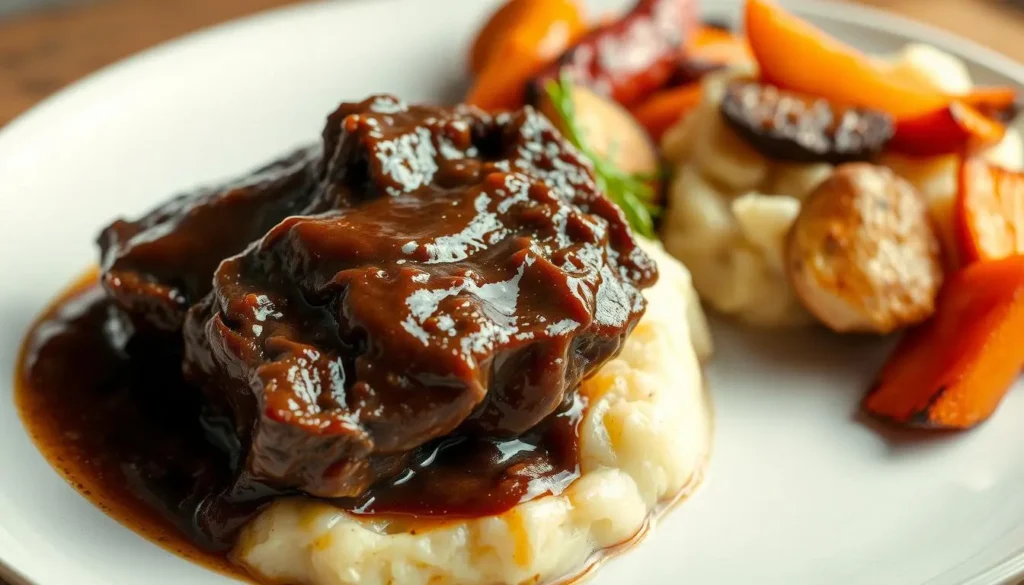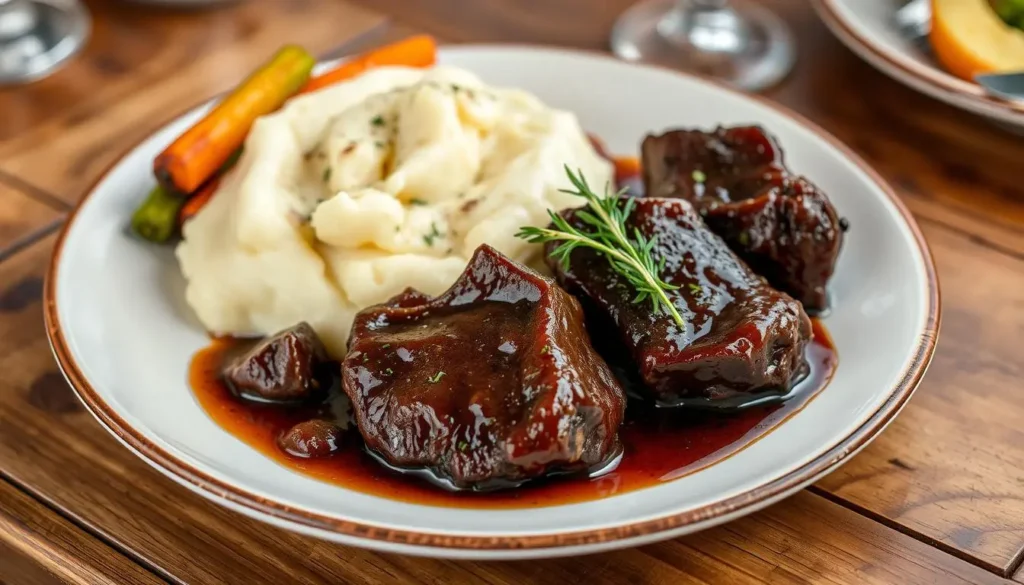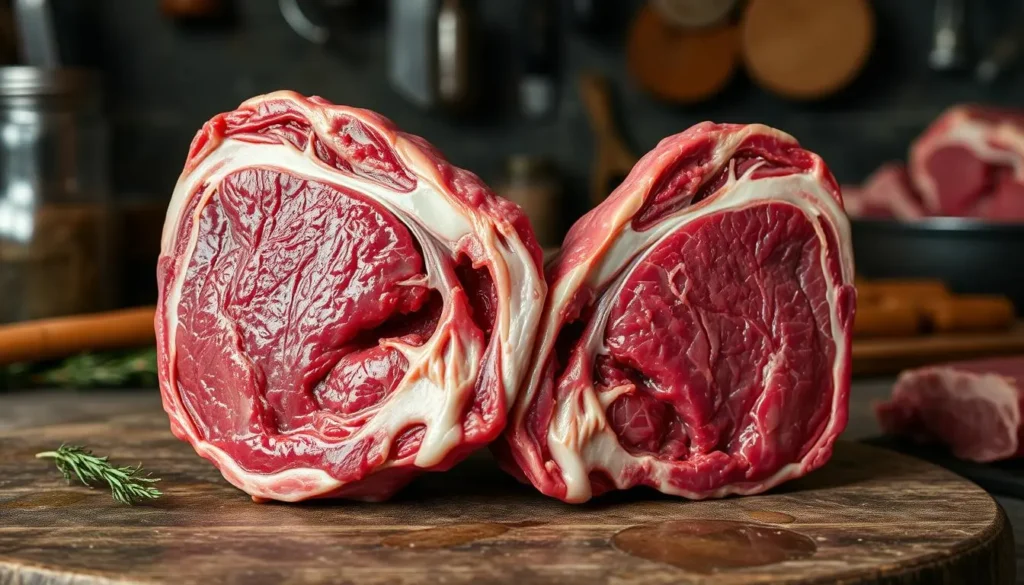Are Beef Cheeks Like Brisket?
Ever wondered if beef cheeks are good meat? They’ve become more popular lately. People are curious about how they compare to brisket. You’ll find out what makes beef cheeks special and how they differ from brisket. This will help you choose the right cut for your next meal.
Beef cheeks provide a rich, tender taste. Knowing their similarities and differences with brisket can enhance your appreciation. You’ll see why beef cheeks are a great choice and how they can make your meal better.
Key Takeaways
- Beef cheeks are a lesser-known cut of meat that offers a unique dining experience
- Understanding the similarities and differences between beef cheeks and brisket can help you make informed decisions
- Beef cheeks are gaining popularity in American cuisine
- Beef cheeks offer a tender and flavorful experience
- Comparing beef cheeks to brisket can help you appreciate their value
- Beef cheeks can be a great alternative to brisket in many recipes
Understanding Beef Cheeks and Their Place in American Cuisine
Have you ever wondered about “beef cheeks” in American cooking? Beef cheeks, or cheek meat, come from a cow’s facial muscles. They are tender and rich in flavor, perfect for slow-cooked dishes.
In the USA, people call them beef cheek meat or simply beef cheeks. Chefs and home cooks love them for their unique taste and texture. They’re affordable and flavorful, making them a great choice for trying something new.
What Are Beef Cheeks?
Beef cheeks are full of connective tissue, ideal for slow-cooked meals like braises and stews. They’re also packed with protein and low in fat, making them a healthy choice.
Common Names for Beef Cheeks in the USA
In the USA, beef cheeks have several names, including:
- Beef cheek meat
- Cow cheeks
- Beef jowls
These names all point to the same meat, taken from a cow’s facial muscles.
Cultural Significance and Growing Popularity
Beef cheeks hold a special place in many cultures, including the USA. They’re used in dishes like tacos and BBQ. Their unique flavor and growing popularity make them a favorite among cooks.

The Basic Anatomy of Brisket
Exploring beef, you’ll learn brisket’s anatomy is key to its special traits. It comes from the cow’s lower chest or breast. This makes brisket known for its unique texture and taste. Compared to beef cheeks, brisket has more uniform tissue.
Brisket has two main parts: the flat cut and the point cut. The flat cut is leaner and tender. The point cut is fattier and tastier. This affects how brisket is cooked and prepared. Beef cheeks have a complex muscle structure, needing slow cooking to soften the tissue.
Cooking brisket, fat content and marbling are crucial. Brisket’s rich, beefy taste comes from its fat and connective tissue. In contrast, beef cheeks have a deeper, richer flavor from their fat and slow cooking.
Important brisket factors include:
- Fat content and marbling
- Muscle structure and composition
- Connective tissue and cooking methods
Knowing these, you’ll better appreciate brisket and beef cheeks. You’ll also know how to bring out their best flavors and textures.
Are Beef Cheeks Like Brisket? A Direct Comparison
When we talk about whether beef cheeks are good meat, comparing them to brisket is key. Both cuts come from different parts of the cow but share some traits. Yet, their textures, fat levels, and tastes are quite different.
Beef cheeks are tender and velvety, perfect for slow-cooked meals. Brisket, on the other hand, has a rich flavor and a firmer texture. It needs special cooking to become tender.
Texture and Fiber Structure
Beef cheeks have finer fibers than brisket, making them tender. This is why they’re great for dishes where you want to highlight the meat’s taste and texture.
Fat Content and Marbling
Beef cheeks have less fat than brisket but still have enough marbling. This marbling boosts their flavor and tenderness. Brisket, with more fat, can dry out if not cooked right.
Flavor Profile Differences
Beef cheeks taste rich and slightly sweet. Brisket has a deeper, more savory flavor. Choose based on the flavor and texture you want in your dish.
Choosing between beef cheeks and brisket depends on your taste and the dish you’re making. Knowing their differences helps you pick the right cut for a delicious meal.
Price Points and Market Availability
Beef cheeks often have a higher price. But why is this? The cost comes from several factors. They are a premium cut, and their limited availability increases demand and price.
Preparing beef cheeks is also time-consuming. They need slow-cooking to become tender. This process requires extra effort, leading to higher prices at restaurants and butcher shops.
Factors Contributing to High Prices
- Limited availability
- Time-consuming preparation process
- High demand from restaurants and consumers
Despite the cost, many want to try beef cheeks. They offer a unique flavor and texture. You can find them at specialty butcher shops or high-end restaurants. Be ready for a higher price, but enjoy a delicious experience.
Seasonal Availability and Where to Buy
Beef cheeks are available all year, but prices change with the seasons. You can find them at local butcher shops, specialty stores, or online. Look for fresh ones with good fat content for better tenderness and flavor.
Nutritional Profile Comparison
When comparing beef cheeks and brisket, you might wonder about their nutritional values. Both are packed with essential nutrients, but they differ in some key areas. Beef cheeks have more protein and less fat than brisket.
A 3-ounce serving of beef cheeks has about 22 grams of protein, 10 grams of fat, and no carbs. Brisket, on the other hand, has 20 grams of protein, 15 grams of fat, and no carbs. Here’s a detailed look at their nutritional profiles:
- Protein content: beef cheeks (22g), brisket (20g)
- Fat content: beef cheeks (10g), brisket (15g)
- Calories: beef cheeks (150), brisket (200)
Beef cheeks are leaner than brisket. But both are full of iron, zinc, and other important minerals. So, whether you pick beef cheeks or brisket, you’re getting a meal rich in nutrients.
Both beef cheeks and brisket have health benefits. The protein in beef cheeks helps build and repair muscles. The iron in both cuts supports healthy red blood cells.
| Nutrient | Beef Cheeks | Brisket |
|---|---|---|
| Protein | 22g | 20g |
| Fat | 10g | 15g |
| Calories | 150 | 200 |

Cooking Methods for Beef Cheeks
Cooking beef cheeks right is key to tender and tasty results. The secret is in the cooking method. You can make braised beef cheeks by combining different techniques. Low and slow cooking is crucial to break down the meat’s connective tissues.
Popular methods include braising, slow cooking, and pressure cooking. These methods cook the meat for a long time. This makes the braised beef cheeks tender and juicy. Here’s how to do it:
- Braising: Cook the beef cheeks in liquid on low heat for 2-3 hours.
- Slow cooking: Cook the beef cheeks in a slow cooker for 8-10 hours on low heat.
- Pressure cooking: Cook the beef cheeks in a pressure cooker for 30-40 minutes.
It’s important to watch the temperature and time closely. The beef cheeks should be cooked to 160°F – 170°F (71°C – 77°C). By following these tips, you’ll make braised beef cheeks that everyone will love.
Always use a meat thermometer to check the beef cheeks’ temperature. Let them rest for 10-15 minutes before serving. With these methods and tips, you’ll make deliciously tender and flavorful braised beef cheeks.
| Cooking Method | Temperature | Time |
|---|---|---|
| Braising | 300°F (150°C) | 2-3 hours |
| Slow cooking | 275°F (135°C) | 8-10 hours |
| Pressure cooking | 250°F (120°C) | 30-40 minutes |
Traditional Brisket Preparation Techniques
Preparing brisket requires exploring different techniques to get it just right. While beef cheeks are loved, brisket has its own special ways. You can smoke, barbecue, or oven-roast it to enhance its rich flavors.
Seasoning and marinating are key. A great marinade can make your brisket tender and flavorful. Here are some seasonings to try:
- Salt and pepper
- Garlic and herbs
- Spicy rubs
After seasoning, choose your cooking method. Smoking and barbecuing are excellent for tender brisket. But, you might hit the “brisket stall.” To beat it, wrap the brisket in foil or crank up the heat.
For a closer look at cooking, check out this table:
| Cooking Method | Temperature | Time |
|---|---|---|
| Smoking | 225-250°F | 4-5 hours |
| Barbecuing | 275-300°F | 3-4 hours |
| Oven-Roasting | 300-325°F | 2-3 hours |
By using these traditional methods, you’ll make a delicious brisket. And, you might just find that beef cheeks pair perfectly with it.
Best Uses for Each Cut
Beef cheeks and brisket are great for many dishes. They’re perfect for hearty stews or tender tacos. For instance, braised beef cheeks are excellent for beef cheek tacos or beef cheek ragu. These dishes are perfect for special occasions or cozy nights.
Here are some ideal dishes for beef cheeks and brisket:
- Beef cheek ragu: a classic Italian dish with braised beef cheeks, tomatoes, and herbs
- Beef cheek tacos: a spicy Mexican dish with braised beef cheeks, salsa, and avocado
- Traditional barbecue: a classic American dish with slow-cooked brisket, great for outdoor gatherings
Exploring these dishes and cooking methods can help you discover beef cheeks and brisket’s unique qualities. They can add flavor to your meals. Whether you want something hearty or spicy, braised beef cheeks and brisket will impress.
| Dish | Ingredients | Cooking Method |
|---|---|---|
| Beef cheek ragu | Beef cheeks, tomatoes, herbs | Braising |
| Beef cheek tacos | Beef cheeks, salsa, avocado | Grilling or pan-frying |
| Traditional barbecue | Brisket, barbecue sauce | Slow-cooking |
Tips for Selecting Quality Cuts
Choosing the best beef cheeks and brisket is key to great dishes. To answer if are beef cheeks good meat?, look at their marbling. Marbling makes the meat tender and flavorful.
A quality beef cheek has a rich color and firm texture. Check for freshness with a pleasant, sweet smell. For brisket, grade and size matter. A higher grade means it’s tender and tasty.
What to Look for in Beef Cheeks
- Color: Look for a deep red color with a fine marbling of fat
- Texture: Choose beef cheeks with a firm, springy texture
- Freshness: Check for a pleasant aroma and a fresh appearance
Brisket Selection Guide
For brisket, consider these factors:
| Factor | Description |
|---|---|
| Grade | Choose a higher grade for more tender and flavorful meat |
| Size | Select a brisket that is suitable for your cooking needs |
| Fat Cap Thickness | Opt for a brisket with a thicker fat cap for more flavor |

Conclusion: Making the Right Choice Between Beef Cheeks and Brisket
Beef cheeks and brisket are both tasty and flexible cuts of beef. They are good for different dishes because of their unique qualities. Your choice depends on what you like, how you cook, and the dish you’re making.
Beef cheeks are tender and buttery. They have a rich flavor and get very soft when cooked slowly. They’re great for braised beef cheeks, beef cheek tacos, or as a short ribs substitute. Brisket, on the other hand, is perfect for hearty dishes like smoked brisket, corned beef, or beef stew.
Choosing the right cut is important. Look for high-quality, marbled pieces. Use the right cooking methods to enhance the flavor. With this advice, you can pick between beef cheeks and brisket. You’ll make dishes that are delicious and will wow your guests.
FAQ
What are beef cheeks called in the USA?
In the USA, beef cheeks are known as “braising cheeks” or “chuck cheeks.” They might also be called “beef cheek” or “cheek meat” in some places.
Are beef cheeks good meat?
Yes, beef cheeks are excellent meat. They are tender and full of flavor when cooked correctly. Braising or slow cooking makes them perfect.
Why is beef cheek so expensive?
Beef cheeks are pricey because they’re not common and are in demand. They come from a small muscle, so there’s less of them. Also, cooking them takes a lot of time and effort, which adds to the price.
What is the best way to cook beef cheeks?
The top way to cook beef cheeks is braising. This means searing them first, then simmering them in liquid until they’re tender. Slow cookers or pressure cookers also work well.
How do beef cheeks differ from brisket?
Beef cheeks and brisket are both tasty and tough, but different. Beef cheeks come from the cow’s head and are smaller and tender. Brisket is from the chest and is bigger and tougher. Beef cheeks cook faster and have less connective tissue than brisket.

